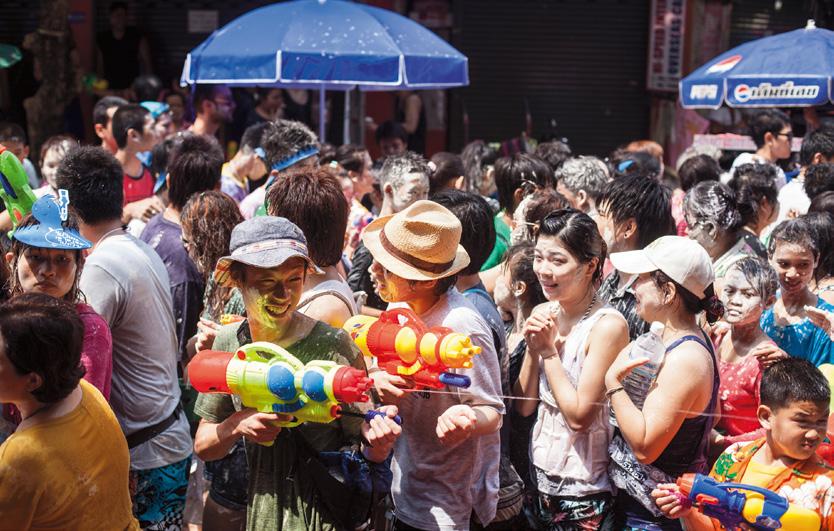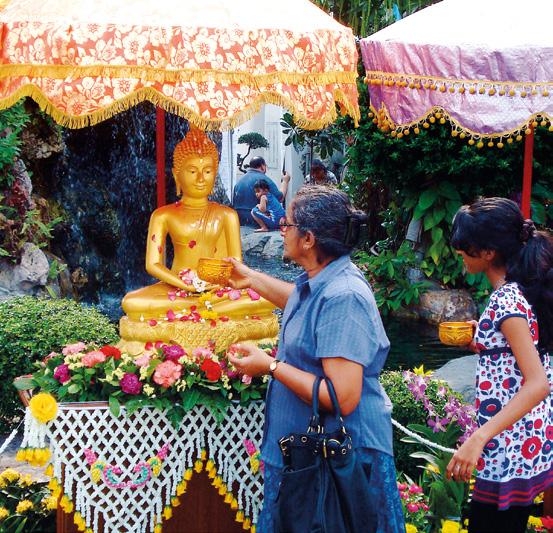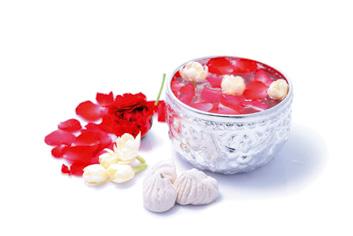
4 minute read
Songkran
Thailand’s Splish Splash Festival 101
One of the hottest and driest times of the year in Thailand is typically from March to June. April is supposedly the warmest month of summer which marks the 13th every year as Songkran or Thai New Year’s national holiday until the 15th. The festival has long been celebrated nationwide by Thais and foreigners residing in the country or visiting for vacation. While some traditions are still preserved, it’s fair to say that new practices have reinterpreted the initial meaning and purpose of Songkran.
Advertisement
History & Origin
Since the Ayutthaya period, the original purpose of Songkran has been to celebrate the Thai New Year. The celebration changed in 1940 when the New Year date was officially shifted to 1 January. The traditional Thai New Year is celebrated as holidays since.
The word ‘Songkran’ comes from the Sanskrit word ‘sam . krānti,’ meaning movement, indicating the motion of the sun passing from one zodiac to another. For this reason, Songkran occurs every month in Sanskrit definition.
In the Thai context, the Maha Songkran period signifies the motion of the sun turning from Pisces to Aries as the beginning of a new year according to the Indian solar calendar. There are also beliefs that Songkran activities might be influenced by Holi festivities in India where people throw coloured powder at one another.
Locations
The four main regions in Thailand keep a variety of traditions during Songkran, some are different and others share similarities. In the north, people organise Buddha statue parades. Guns are shot and firecrackers are lit up to expel evil spirits and negativities. The locals also clean their houses and cleanse their bodies. No bad words shall be uttered and no arguments or fights shall take place.

In the central part of the country, people gather at homes to feast on Khao Chae or rice soaked in cold water paired with a number of specific side dishes adapted and modified from a Mon recipe. Some side dishes include Kapi balls, stuffed shallots, stuffed sweet peppers, stir-fried sweet pickled Chinese turnips with eggs, raw mango, fresh cucumber, wild ginger, chillies and spring onions.
In the northeastern region (Isaan), temple fairs are held for three days straight with urban plays and dances. And in the south, people stop all kinds of work and get ready to welcome a new City God. All these locations pay respect to the elders as a top priority.
Traditions
Songkran is a time of change and also a time of cleansing, ridding of the bad and welcoming the new and the good. It is also a time to show respect and humility to the elders. This is usually held on the first day of Songkran with an old custom called ‘Rod Nam Dum Hua’ (rót náam dam hŭa).
The younger family members pour rose- and jasmine-scented water into the palms or feet of their parents and elders and offer them flower garlands. They also ask for blessings on the occasion of the Thai New Year. This is to help wash away the bad things in life and welcome good fortune.

Another ritual is the bathing of the Buddha statues or ‘Song Nam Phra’. The words literally mean to ‘pour water over monks.’ It is an essential ceremony where Buddhists gently pour scented water over the Buddha images on the altar dressed and decorated with flowers and offerings.
This can be done at home or at temples. There are also many altars set up at various locations such as in the department stores, in the lobby of condominiums or hotels, and in numerous locations around town for the public to pay their respect. Songkran is also seen as a spring cleaning time and many Thais would take this opportunity to thoroughly rearrange the interior and exterior of their houses to welcome the new year. Since Songkran is considered as the Buddhist Holy Days, Buddhists attend the ceremony and pray at nearby community temples, make merit and give alms to monks as well as attend the evening prayers.
Cultural Importance
In terms of religion, Buddhists make merit and use water as a medium to show gratitude and good intentions towards each other. Families bring food offerings to the temple for the monks, keep the right conduct and morality and baste the Buddha statues for luck, health and prosperity. On this occasion, the merit they make often goes to the deceased ancestors. The water-pouring ceremony reflects the importance of family bonds in Thai culture. The youth take this chance to honour their parents and grandparents, likewise, Buddhists to the monks and the junior to the senior.
Modern Context
Water throwing and Songkran entertainment have escalated in recent years. People previously threw clean water at each other in public with water dippers to beat the heat of the weather as well as to create unity and protect the cultural heritage. Now, many bring water guns into play in which the dangerously powerful ones are banned along with excessive use of the off-white powdery clay, ‘Din Sor Pong’, that could cause sewer blockage. In some districts, water throwing becomes warlike to the extent that cars are involved. The splashing also carries on in annual music festivals during the celebration.
Reference:
www.m-culture.go.th arts.tu.ac.th/culture/Book_Songkran2016.pdf en.wikipedia.org/wiki/Songkran_(Thailand)










